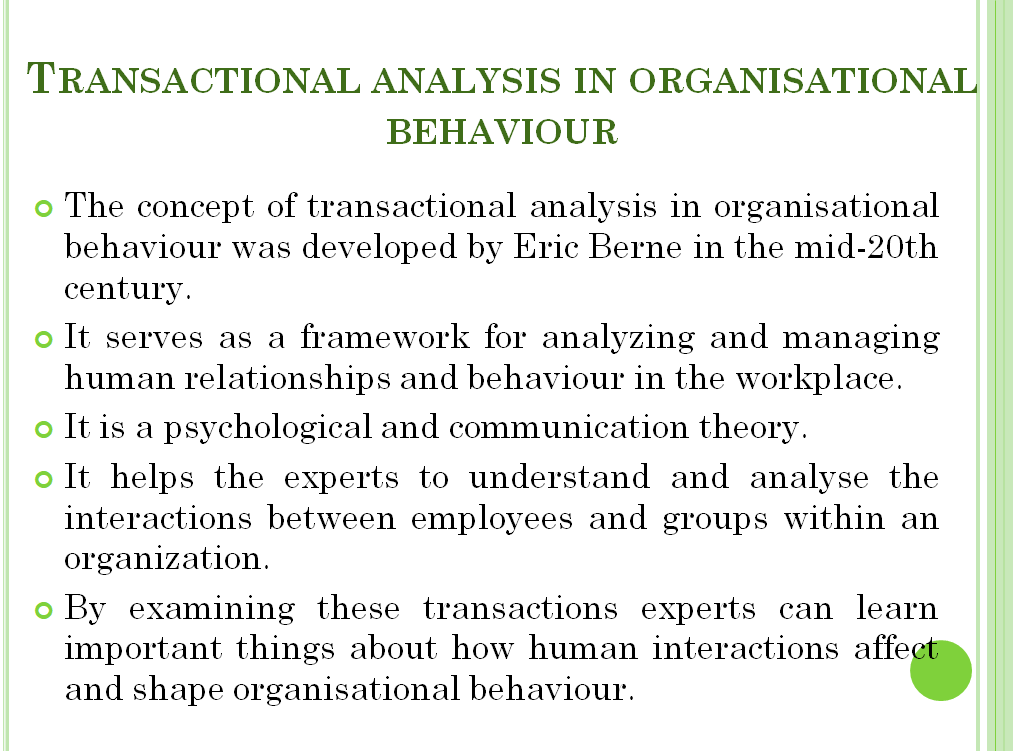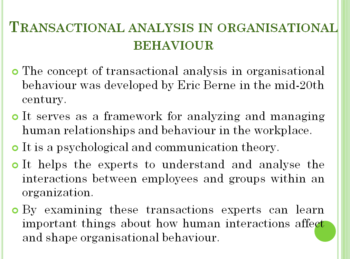Table of Contents:-
- Meaning of Transactional Analysis in organisational behaviour
- Definition of Transactional Analysis in organisational behaviour
- Nature of Transactional Analysis in organisational behaviour
- Objectives of Transactional Analysis in organisational behaviour
- Benefits of Transactional Analysis in organisational behaviour
- Limitations of Transactional Analysis in organisational behaviour
Eric Berne developed the concept of transactional analysis in organisational behaviour in the mid-20th century. It serves as a framework for analyzing and managing human interpersonal relationships and behaviour in the workplace.
Meaning of Transactional Analysis in Organisational Behaviour
In 1950, Eric Berne developed a socio-psychological concept termed transactional analysis. Since then, the theory of Erie Berne has been applied in psychotherapy, counselling, education, and organisational development. The primary objective of transactional analysis is to help people understand how to communicate with others to improve their relationships with others.
Transactional analysis plays a vital role in analysing and understanding one’s behaviour as well as the behaviour of others. It guides people on how to develop themselves and interact with others. It also provides various ideas that help an individual change his behaviour, which ultimately results in the growth of an individual.
According to Eric Berne, “Transactional analysis is a theory of personality and social action and a clinical method of psychotherapy, based on the analysis of all possible transactions between two or more people, based on specifically defined ego states into a finite number of established types”.
Transactional analysis in organisational behaviour is a psychological and communication theory. It helps the experts to understand and analyse the interactions between employees and groups within an organization. By examining these transactions, they can effectively understand how people interact and share ideas in the workplace. This helps them to learn important things about how these interactions affect and shape organisational behaviour.
Nature of Transactional Analysis in Organisational Behaviour
The nature of Transactional Analysis in Organisational Behaviour can be described as follows:
1) TA is an integrated concept because it blends the theory of development and practice of socio-psychology. This theory encloses fundamental concepts associated with Freudianism and brain research. TA describes relationships between the intellect and individuals.
2) TA is problem-focused as well as goal-focused. The objectives of change under TA are independence (freedom from childhood script), impulsiveness, closeness, and problem-solving
3) TA is an essential and exciting technique that helps individuals understand themselves and others’ behaviour. It helps people determine the influence of behavioural styles on interpersonal relationships. Transactional analysis is a behavioural approach that helps in improving communication among people. TA can be used to determine people’s skills during training and development.

Objectives of Transactional Analysis in Organisational Behaviour
Objectives of Transactional Analysis in Organisational Behaviour are as follows:
1) To help people understand how to communicate with each other to improve their communication skills effectively.
2) To identify various transactional stages that people engage in during communication.
3) To determine the ego states to which people belong.
4) To make people self-reliant and enable them to make life decisions on their own.
5) Develop a better understanding of people by identifying areas of improvement in communication with self and others.
Benefits of Transactional Analysis in Organisational Behaviour
The benefits of transactional analysis can be summarised as follows:
1) Executive Development
It helps enhance managers’ skills so that they can tackle the problems employees face more efficiently. However, TA can only provide solutions for some organizations’ human-related issues.
2) Counselling
Transactional analysis is used by counsellors to resolve problems. Counselling emphasises developing productive solutions to problems. Transactional analysis helps counsellors in creating safe and harmonious relationships with their clients. This relationship allows clients to enhance their quality of work life.
3) Organisation Development
Transactional analysis assists in the organisational development process. Organisational development specialists utilise TA concepts to develop policies to fulfil specific organisational needs and develop practical relations with others. It also helps in removing defective behaviours and evaluating the entire organisation.
Jongeward has defined the functions of TA in the following areas of organisational development:
- To retain adult-adult transactions,
- To provide an OK response to the natural child,
- To speedily recognise the crossed transactions,
- To decrease negative game-playing,
- To make the best use of familiarity, and
- To build up encouraging systems, strategies, and working environment.
4) Conflict Resolution
TA and conflict resolution techniques are naturally related to each other. For example, a parent’s ego focuses on utilising a forcing strategy, whereas a child’s ego focuses on avoiding an approach. People in the “I am O.K., you are O.K.” life position generally prefer those strategies in which both parties are happy with the solution and adopt the adult ego state. The relation among various sets of behavioural facts and activities is distinct.
Table: Possible links of life positions with conflict resolution techniques and behaviour
| Life Position | Conflict Resolution Techniques | Possible Behaviour |
| I am not OK – you are not OK | Avoidance | Non-assertiveness |
| I am not OK – you are OK | Smoothing | Non-assertiveness |
| I am OK – you are not OK | Forcing | Aggressiveness |
| I am OK – you are OK | Confronting | Assertiveness |
5) Interpersonal Effectiveness
TA helps people understand various ego states, which ultimately enhances their relationships. Using TA, managers can quickly identify the ego states of people involved in a particular communication. When a person can understand himself and others, he becomes more efficient, self-assured, and self-confident. Hence, the organisation becomes more effective with better interpersonal relationships and understanding.
6) Diagnosis and Treatment of Psychological Disorders
Various kinds of psychological disorders can be analysed and cured with the help of TA. It offers healing methods for everyone: individuals, groups, families, and couples. Transactional analysis in organisational behaviour explains the psychological structure of people. It uses one of the best-known models, i.e., the ego-state (Parent-Adult-Child) model, to achieve this objective. This model helps realize how people perform their functions and convey their behaviours to others. It also brings forward the concept of “Life Script,” i.e., a story that an individual forms about his life to find out the answers to questions like “How do I move forward in life?” and “What type of person am I?”. So, TA provides a theory of psychopathology.
7) Education
Educators utilise basic concepts of transactional analysis to help their students understand their behaviour as well as the behaviour of others. Undergraduates and postgraduates can learn more effective methods of communication and mutual attention through TA. Educators use fundamental transactional analysis concepts to create a universal understanding of personality. TA work applies to different areas of learning and brings together various learning practices.
8) Leadership
Managers generally restrict their choice of leadership style when they interact through a single ego state. For example, a person with a dominant parent ego will adopt an autocratic manner. The free-rein technique can be applied if the child state is leading. But, when a supervisor feels “I am OK-You are OK” and has attained a fully grown adult state, he will first gather information before choosing a leadership style. The style selected by the adult state will give flexibility to employees to take part in decision making activities.
Related Articles:
- nature of marketing
- difference between questionnaire and schedule
- features of marginal costing
- placement in hrm
- limitations of marginal costing
- nature of leadership
- difference between advertising and personal selling
Limitations of Transactional Analysis in Organisational Behaviour
Limitations of transactional analysis are as follows:
1) Promotes Amateur Psychologising
TA promotes “amateur psychologising” when it is used with insufficient training. Jargons associated with TA may need more information to handle human beings.
2) Complex to Understand
Practically, it is not easy for less educated people to understand the concept of ego states and transactions.
3) Method of Manipulation
TA is a critical statement in interpersonal relations. Certain persons could use this method to influence the behaviour of others, as in the case of hidden transactions.
4) Not Supported by Scientific Findings
The efficiency of transactional analysis needs to be more supported and accepted by scientific studies.
Hence, one should use TA carefully. Executives should first learn about this method and then practice handling workers efficiently.
FAQs
1. What are the 3 stages of transactional analysis?
The three stages of transactional analysis are the Parent, Adult, and Child Ego stages. These Stages are a consistent set of patterns which give a deep understanding of one’s behaviour and communication. An individual may choose to feel, think, or behave in any one or all of the three stages.
-
-
- Parent: One responds the way a parent or guardian would.
- Adult: One responds here and straightforwardly.
- Child: One responds to the emotions experienced as a child.
-
You May Also Like:-
Nature of Organisational Behaviour
Conceptual Foundation of Organisational Behaviour
Contributing Disciplines to organisational behaviour
Models of Organisational Behaviour
Approaches of Organisational Behaviour
Emotional Intelligence in Organisational behaviour
Factors Influencing Perception
Scope of Organisational Behaviour
Importance of Organisational Behaviour
Challenges and Opportunities of Organisational Behaviour
Factors affecting group behaviour
Causes of Conflict in an Organisation
Types of Conflict in an Organisation
Organisational Development Process
Factors Affecting Organisational Culture
Trait Theory: Stogdill’s trait factors
